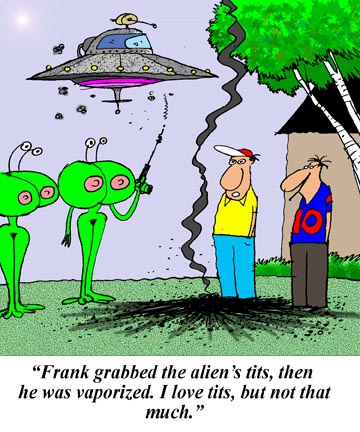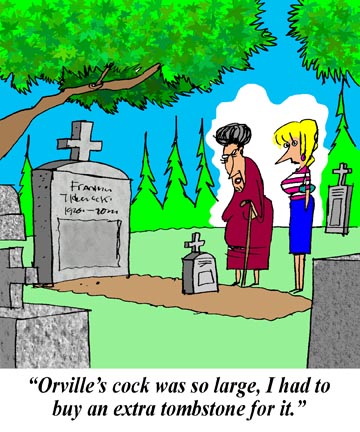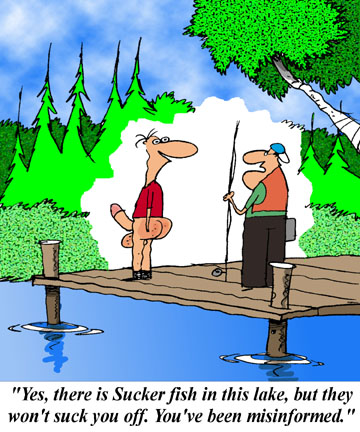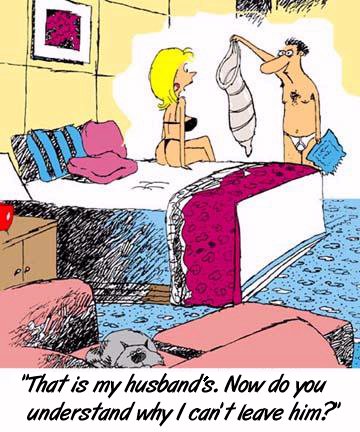 |
|||||
|
Sexual Humour: A Feminist Critique
Where’s the Joke? The Meaning Behind Sexual HumourBy Penelope W. Brunner, Ed.D. & Melinda L. Costello, Ph.D. - 2002. Yet, if humour, and particularly sexual humour, is being used to undermine power, then women seeking success in management roles need to be aware that even subtle sexual or gender-related joking may be blocking their path to the top. To laugh or not to laugh? That seems to be the question. With every article on workplace stress comes another recommendation for including more humour on the job. However, there is corresponding research showing that office humour may lead to such negative repercussions as sexual harassment charges. In 1980 the Equal Employment Opportunity Commission (EEOC) published the guidelines that define sexual harassment as “Unwelcome sexual advances, requests for sexual favors, and other verbal or physical conduct of a sexual nature” (Rutter, 1997, p. 10). These guidelines also define harassment as the creation of a hostile or intimidating working environment; it is such an environment that serves as the basis for numerous work-related lawsuits. The EEOC classifies unwelcome behavior into seven forms, and according to a U. S. Merit Systems Protection Board study, the most frequent form cited includes “sexual teasing, jokes, remarks, or questions” (Rutter, 1997, p. 11). Under EEOC guidelines and employment law, the kinds of sexual communication or behaviors that were previously considered harmless in the workplace may now be illegal. And yet, human beings remain sexual beings regardless of governmental rules and regulations, so our use of humour is increasingly a source of confusion and perplexity.
However, the study of humour, for the most part, either overlooks sexual humour as it occurs in organizations or is limited to an analysis of whether or not a joke is sexual harassment; the meaning behind sexual humour is generally ignored. Lundberg’s (1969) joke labeling scheme totally omits the sexual content of jokes other than to include a disclaimer that excuses the sexual frolics as typical. Vinton (1989) categorizes humourous interactions observed at a small family-owned corporation in the Midwest, but labels obviously sexual jokes as mere “bantering” ( p. 161); a recategorization of Vinton’s data indicates that sexual humour is more pervasive in her setting than she reports. Other researchers (Decker, 1987; Hemmasi, Graf, & Russ, 1994; Herzog, 1999; Prior, 1995; Wilson & Molleston, 1981) study different perceptions of sexual humour and, in some cases, explore how far sexual humour can go before it is considered offensive. Duncan, Smeltzer, and Leap (1990) provide a framework for exploring the evolution of humour’s various roles, including when humour “deteriorates into harassment” (p. 257). Fritz (1997), Hemmasi and Graf (1998), Rutter (1997) and Schaefer and Finegold (1995) also contribute to the understanding of humour and harassment in the workplace, but none focuses on the purpose of sexual humour or examines the meaning behind the jokes. A study by Spradley and Mann (1975) goes a step further and proposes that sexual humour plays a role in leadership, power, and status relationships; we agree with this proposition. We also suggest that sexual humour may disguise attitudes toward gender roles and may be used to maintain an existing organizational structure. Analysis of these attitudes and their implications should not be ignored in our efforts to understand organizational behavior and gender relationships and should invite further consideration and examination. Recognizing that sexual humour may be used, consciously or unconsciously, to undermine power and control may help women in their quest to comprehend, and effect change in, the existing workplace hierarchy.
Humour Sends a Serious Message In order to discuss sexual humour in organizations one must understand the complexity and illusion that surround the constructs of sexuality, gender, and humour. In this sense, we define sexuality in the words of Burrell and Hearn (1989), “The social expression or social relations of physical bodily desires, by or for others, or for oneself” (p. 2). Sexuality and gender are “intimately related” and Burrell and Hearn (1989) include both in what they call the “sexuality of organization” (p. 2). We use the term “sexual humour” to describe humour that relates to issues of either gender or sexuality. Hearn and Parkin (1987) present four “fronts” of sexuality in organizations: (a) visible, such as open sexual liaisons; (b) secret, such as sometimes uncirculated documents that pertain to sexuality in the organization; (c) unseen, such as sexual fantasies and desires; and (d) elusive, which overarches the visible, secret, and unseen fronts. The primary front of sexuality in organizations is the elusive because, as Hearn and Parkin (1987) write, “On the one hand, we have discovered the ‘ever-presentness’ of sexuality in organizations and the ways it can permeate, influence and be powerful; on the other, sexuality almost always remains ‘one step removed’ from being pinned down, measured and researched unambiguously” (p. 123). Given this elusive nature of sexuality, it is easy to see how ambiguous, gender-related messages are often sent on a humourous vehicle. According to Mulkay (1988), there are two different forms of discourse--serious and humourous--and different rules of interaction apply in each mode. Assumptions made by the listener in the serious mode are not appropriate in the humourous mode. Humour provides a perspective that would not be appropriate in the serious mode. Although at times there may not be any hidden meaning, a humourous statement may carry significance from the serious realm. The recipient of the humour is left to wonder whether or not there is a serious message because the words can convey both serious and humourous messages at the same time. Humour is the perfect medium in which to couch a serious message because any serious intention and any serious meaning can always be denied (Linstead, 1985; Mulkay, 1988).
Sexual Humour Maintains an Existing Structure While societal norms and discrimination laws target the obvious discrimination practices in organizations, subtle methods of prejudice, such as sexual humour, retain and support an organization’s historical structure and are often overlooked. Although most organizations present themselves as gender-neutral, in actuality most organizations exist according to a masculine identity, and several writers argue that gender and sexuality exist in organizations as part of the process of control (Acker, 1990; Burrell, 1984; Hearn & Parkin, 1983; Walby, 1988). Often this control is demonstrated through maintenance of the status quo. Mulkay (1988) believes humour, and especially sexual humour, is used to preserve existing organizational structures: “It is yet another ‘paradox of the humourous mode’ that, although semantically humour involves confrontation with a subversion of a dominant pattern, it is used most effectively for serious purposes mainly in structured situations where it works to maintain that pattern” (p. 177). Thus, sexual humour may be used to support the patriarchal structure of most workplaces. Seemingly harmless jokes and remarks may undermine a woman’s advancement, thereby preserving the existing power base.
Kahn’s (1989) article concerning organizational diagnosis and change demonstrates how humour sends a message about power relationships. When a male employee mumbles a one-line witticism under his breath, this forces a female consultant to reconsider the gender relationships in their workplace. A female secretary walks into a meeting of the bank’s managers to deliver some papers and accidentally unplugs the slide projector with her foot. A male supervisor’s quick comment about “a woman’s touch” provokes laughter from the men attending the meeting (Kahn, 1989, p. 46). Initially the consultant perceives the men in the bank as liberal and non-sexist but, with some investigation, she finds that the joke signals “issues about resistance to women’s control and authority” (Kahn, 1989, p. 47). This supposedly innocent joke exposes underlying attitudes toward power relationships in the organization. Although these attitudes may not manifest through conversations with organization members, humour provides an acceptable way for men to express these beliefs. This type of brief interaction, recurring repeatedly throughout a normal workday, may indicate and perpetuate assumptions that men make about women’s roles in the workplace.
|
|
||||
|
|
|||||
 Spradley and Mann (1975) also illustrate how sexual humour maintains status and role relationships. In The Cocktail Waitress (Spradley & Mann, 1975), the authors observe a complicated and tricky pattern of joking between the exclusively male bartenders and the female waitresses. It takes time for the waitresses to learn how to negotiate the boundary between acceptable joking comments and unacceptable serious insults because, “even when joking, girls must maintain a subordinate position, careful that their ritual insults do not denigrate a male bartender” (Spradley & Mann, 1975, p. 93). Even without the help of the authors’ narrative and interpretation, it is clear that the bartenders’ joking keeps the women subordinate.
Spradley and Mann (1975) also illustrate how sexual humour maintains status and role relationships. In The Cocktail Waitress (Spradley & Mann, 1975), the authors observe a complicated and tricky pattern of joking between the exclusively male bartenders and the female waitresses. It takes time for the waitresses to learn how to negotiate the boundary between acceptable joking comments and unacceptable serious insults because, “even when joking, girls must maintain a subordinate position, careful that their ritual insults do not denigrate a male bartender” (Spradley & Mann, 1975, p. 93). Even without the help of the authors’ narrative and interpretation, it is clear that the bartenders’ joking keeps the women subordinate.
The explicit or subtle sexual humour observed by Spradley and Mann (1975) and Kahn (1989) provides insight into existing power structures and gender relationships. It is interesting to note, though, that most of the research regarding sexual humour does not follow this lead but focuses instead on the legal harassment aspects. Yet, if humour, and particularly sexual humour, is being used to undermine power, then women seeking success in management roles need to be aware that even subtle sexual or gender-related joking may be blocking their path to the top. As organizations, and organizational researchers, seem to focus primarily on finding the formula for avoiding sexual harassment litigation, popular culture and the media, paradoxically, seem intent on projecting an image that says work relationships are more rife with sexual innuendo and power trips than ever before. If television may be considered in any way a mirror of what society deems normal or acceptable, then even a superficial, non-scientific review of programming would reveal that, as in the past, sexual humour is still being used to define roles. Much of the humour in the media involves sexual situations and put downs and is considered funny because others can relate to it. However, as Spradley and Mann (1975) demonstrate, humour is often used to keep a character in her place; and many times that place is subordinate.
Conclusion Sexual humour’s prevalence in the workplace seems to imply a normalcy that is accepted until it crosses the legal harassment line. Research that defines the boundary of acceptable sexual humour probably helps some organizations avoid legal action but does not address the possibility that sexual humour supports an existing organizational framework that is harmful to the advancement of women. We conclude that sexual humour perpetuates men’s domination of women while appearing innocent of intent, and in this way, supports the existing patriarchal, social structure of organizations. Women need to recognize that even if sexual humour does not cross the boundary into harassment, it still may communicate a deeper, and darker, meaning. Is it possible that humour can be used in an organization in a way that promotes equality and does not diminish the power of men or women? In 1978, Neitz suggested that office humour should change in content to reflect the awareness of the power contained in the male narrative. This humour would allow laughter by both men and women at the expense of neither, “Laughter in this sense is only possible between equals; when men and women can both tell jokes, and can both laugh together perhaps the content will reflect the change, with neither needing to assert superiority over the other through their jokes, or in other patterns of interactions” (Neitz, 1978, p. 222). Mary Crawford (2000) also acknowledges that sexual humour “maintains a sexist social order” (p. 220), but she suggests that humour may “subvert the social order and create new realities” (p. 224). Perhaps Neitz (1978) and Crawford (2000) are optimistic in their thinking, or just ahead of their time. Their proposals imply that organization members have an understanding of how sexual humour is used to perpetuate a male dominated structure, and we present an initial step toward that goal. Women who are leaders in their organizations need to have an understanding of the serious messages that may be hidden in seemingly harmless jokes related to sexuality or gender. Further research exploring the roles of sexual humour should not overlook women’s perspectives, the meaning behind jokes, and how humour may perpetuate relationships that are no longer appropriate.
References
|
|||||
 |
|
 |
|||








